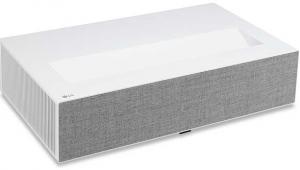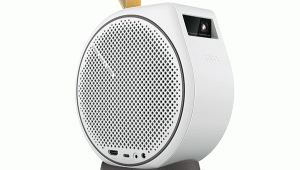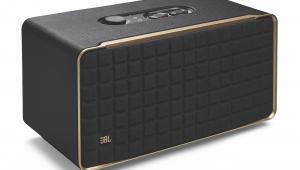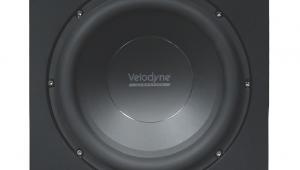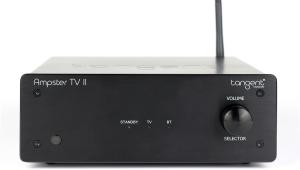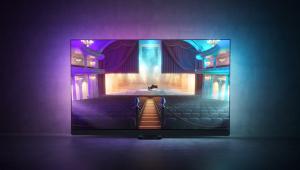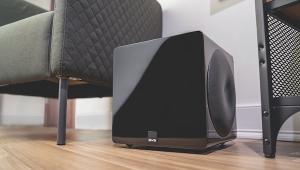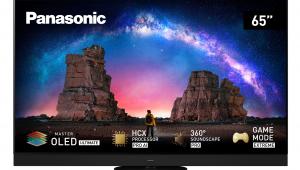BenQ W1050 Full HD projector review
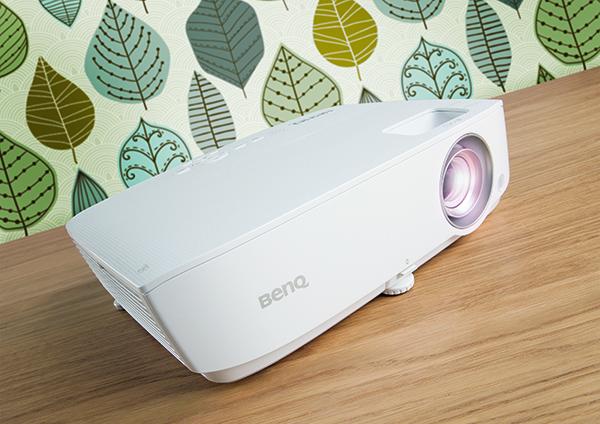
As you’d expect of a projector that knows it’s more likely to live in and out of cupboards rather than being part of a permanent installation, the W1050 is small and portable. It’s cute sculpting and all-white livery, though, ensure that it cuts an attractive dash on your coffee table on movie nights or big sporting occasions.
The W1050’s connections are all found on its rear, and comprise twin HDMIs, a D-Sub PC port, RS-232 control jack and composite video ports. This is pretty much in line with what you get on many substantially more expensive projectors, although a 12V trigger is absent.
There are a few price-related set up limitations, too. For starters, there’s no vertical optical image shifting, leaving a couple of screw-down legs to the rear and a drop-down foot under its front edge to help you get the image positioned correctly on your wall or screen.
This limitation will likely force you to use the projector’s keystone correction to get the sides of the picture straight, even though this essentially involves digitally distorting the video signal.
There’s also only 1.2x of optical zoom available, meaning some households may have to move their coffee table around to ensure the projector delivers the right image size. To help you figure out if this might be you, I can tell you that the W1050 delivers a 100in image from a throw distance of between 2.8m and 3.36m.
Setup also brings you into first contact with the W1050’s deeply unhelpful remote control. This horrible little thing has no backlighting and is dominated by over-small, unhelpfully organised, poorly labelled buttons, making it all but impossible to use in a dark room.
The W1050 picks up the pace with its picture specifications. Its DLP optical system delivers a Full HD resolution (we're not yet at the 4K-for-£500 stage, unfortunately), as well as a promising claimed contrast ratio of 15,000:1. Its high 2,200 Lumens of claimed brightness is a big deal too, as it proves enough to deliver pictures that remain watchable – enjoyable, even – when there’s a degree of ambient light in your room. This is an important feature for the ‘casual’ projection market, even though I'd always urge you to get your room as dark as possible any time you’re using a projector.
The W1050 backs up its versatility by providing Sport, Vivid TV and Cinema modes, all quite astutely designed for different content and viewing environments.
One final noteworthy specification is the ability of the six-speed RGBRGB colour wheel and other optical components to deliver a claimed 96 per cent of the standard dynamic range REC.709 colour space.
Once more unto the beach
Letting the W1050 loose on the 1080p Blu-ray of Dunkirk reveals a picture that is comfortably better than you’ve a right to expect for £500. Mostly light sequences such as the Spitfire dogfights look really punchy and bright. The mix of grey and blue skies looks luminous and lifelike in a dark environment, but also intense enough to stand proud against a little light pollution if completely blacking out your room simply isn’t an option.
The W1050 makes good use of its native Full HD resolution, too. Its images are sharp and crisp enough to show off the subtle difference in grain levels and sharpness between the 1.78:1-ratio Dunkirk footage shot on 70mm film and the 2.20:1-ratio footage captured at a lower grade.
Christopher Nolan's 70mm footage – especially the opening shots in Dunkirk’s streets – appears detailed and clean; full of texture and depth, but also devoid of any signs of forced sharpness such as ringed object edges or exaggerated grain.
The W1050’s freedom from noise extends into three other key areas. First, I only rarely spotted momentary traces of single-chip DLP’s ‘rainbow effect’, where red, green and blue striping can appear over stand-out bright objects (such as the bright bullet holes in the dark hull of the small boat Harry Styles and his chums hide in). Second, dark scenes look pleasingly free of the green dotting noise cheap DLP projectors can suffer with. Third, there’s hardly any fizzing noise over skin tones during camera pans – another common budget DLP projection problem.
The W1050’s contrast performance gives us the clearest glimpse at the projector’s budget origins. There’s a gentle pall of greyness over dark scenes such as the one in Dunkirk where survivors of a night-time torpedo attack flounder in the water waiting to be rescued. And this greyness is heavy enough to obscure shadow detail in the darkest corners, leaving them looking hollow at times.
Typically with a BenQ projector I’d use its Smart Eco picture setting to get the most satisfying contrast results. Oddly, though, with the W1050 I preferred the lowest-brightness Eco setting – at least during dark-room viewing – since this generates much less running noise than any other mode and gives by far the most convincing black colours.
There’s a catch with this whereby having to take as much brightness out of the picture as the Eco mode does also substantially reduces the punch of bright shots. In the end, though, it proves more important to try and make the image look more evened out across dark and light scenes, than to try to force it into delivering a wider contrast range than it’s comfortable with.
The W1050 is also different from most other BenQ projectors where its picture presets are concerned. Usually I’d use BenQ’s Cinema mode, but with the W1050 that crushes out too much shadow detail. Instead I’d suggest the User 2 preset as your most balanced starting point, and experimenting from there.
Colour performance is an area where this budget PJ seems much more assured. Aside from some occasional bleaching caused by that residual greyness over dark scenes (that remains even after you’ve optimised the projector’s settings), the W1050’s colour palette is engagingly rich, neutral, subtle and clearly tuned for video use ahead of PC use. This is refreshing, considering the more ‘business presentation’ tones you sometimes suffer with affordable projectors making a play at the home cinema market.
In keeping with most budget PJs, the W1050 carries a built-in speaker to save you having to connect your image source to an external sound system. Yet the sound from this is so puny that you'll struggle to hear it even when you’re sat right next to the projector. There’s no bass either, and while there’s a marginal sense of the sound projecting beyond the confines of the unit's bodywork, it still feels very dislocated from the onscreen action.
Immersive fun
I should probably veer back to the W1050’s £500 price. While BenQ’s latest projector is inevitably limited in
some ways, these limitations (or at least its picture ones) aren’t nearly as severe as you’d expect for so little money. Watching super-sized films and sporting events on it is immersive fun, just a little rough around the edges. Be prepared to play hunt the remote, and locate a space for the PJ in your room, and you'll find it easy to enjoy.
Specification
3D: Yes. Active shutter 4K: No. 1,920 x 1,080 HDR: No Connections: 2 x HDMI inputs; composite video input; USB service port; D-Sub PC input; RS-232; 3.5mm audio in/out Brightness (claimed): 2,200 Lumens Contrast ratio (claimed): 15,000:1 Zoom: 1.2x Dimensions: 332.4(w) x 99(h) x 214.3(d)mm(d)mm Weight: 2.5kg
Features: Single-chip DLP optical engine; built-in speaker; 4,500/6,000/10,000-hour lamp life in Normal/Eco/Smart Eco modes respectively; 33dB claimed fan noise in Normal mode; 31dB claimed fan noise in Eco mode; Cinema, Sports and Vivid TV picture presets; 1.37-1.64:1 throw ratio; motion processing tech; 210W UHP lamp; vertical keystone correction
 |
Home Cinema Choice #351 is on sale now, featuring: Samsung S95D flagship OLED TV; Ascendo loudspeakers; Pioneer VSA-LX805 AV receiver; UST projector roundup; 2024’s summer movies; Conan 4K; and more
|








